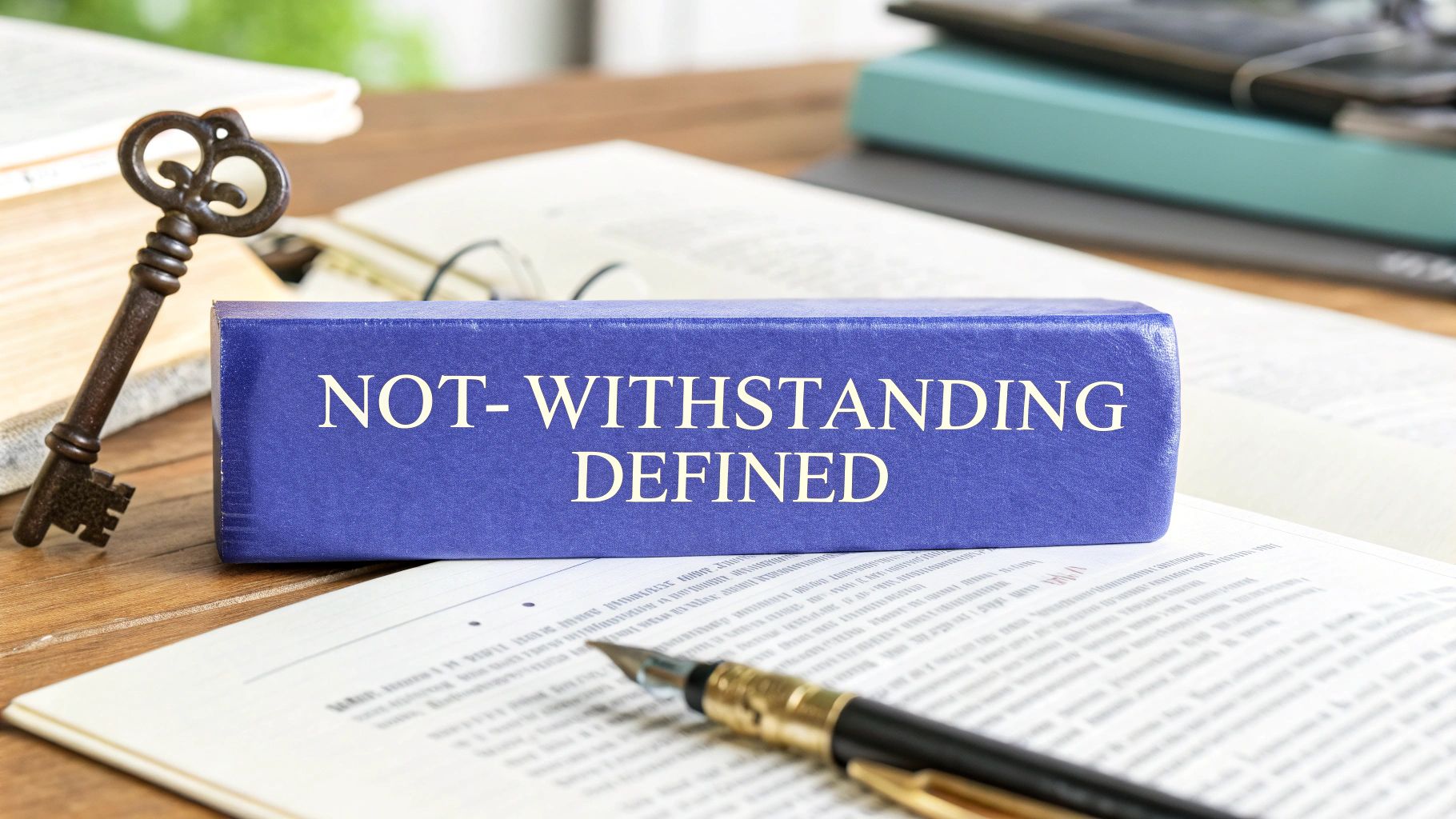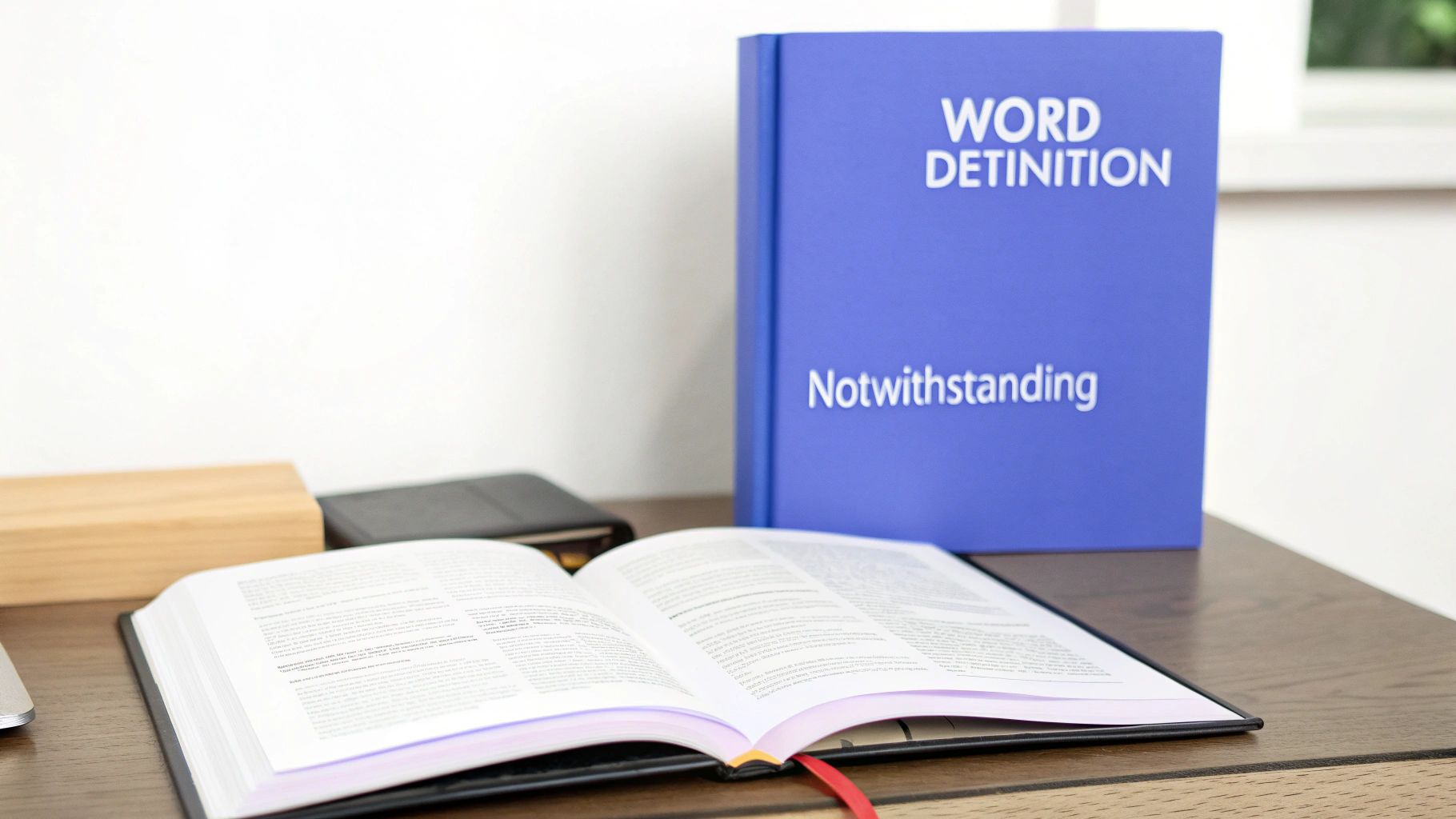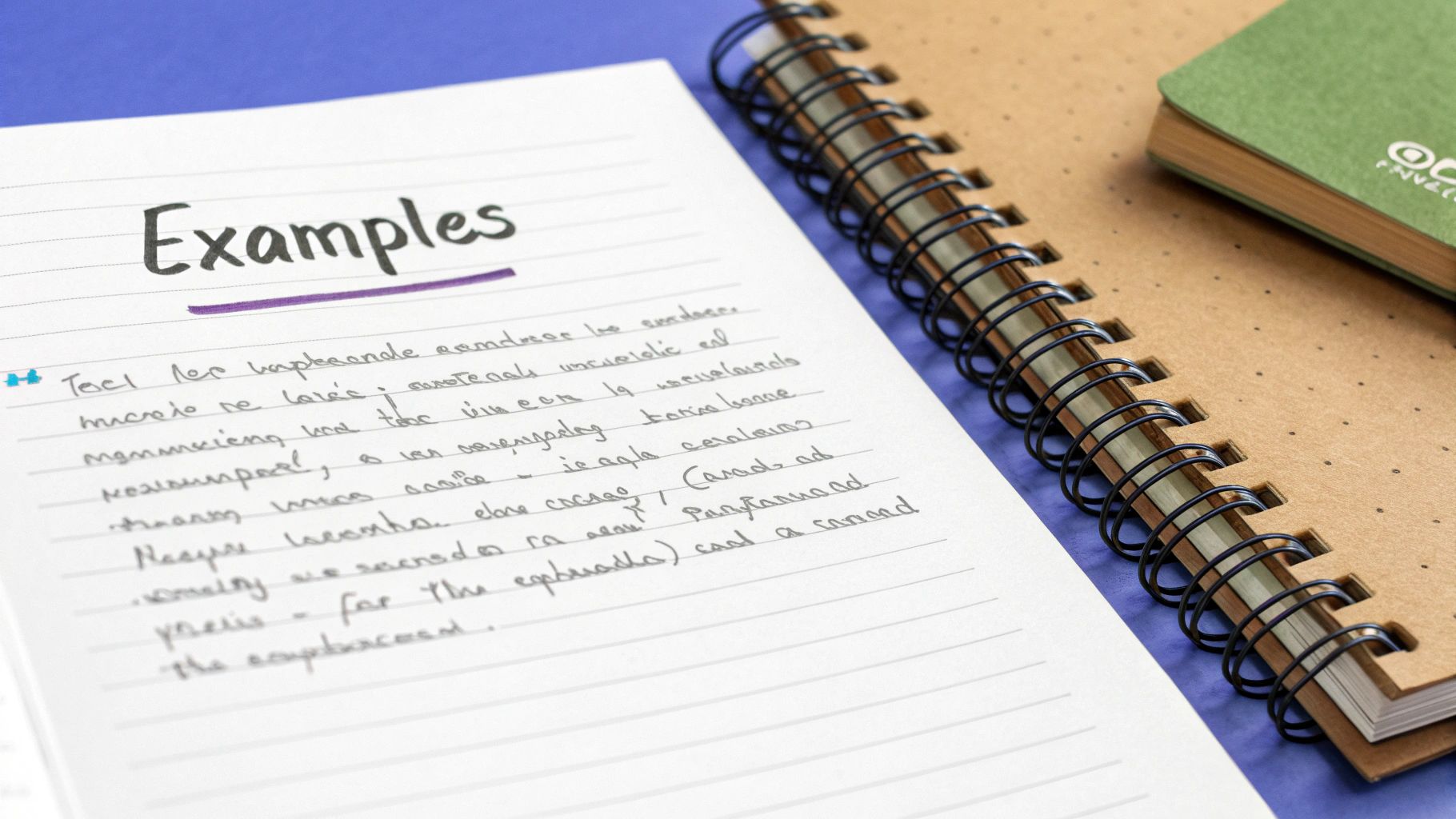
In simple terms, "notwithstanding" means "in spite of" or "despite this." It’s a powerful word that acts like a command in a sentence, telling you that one rule or statement is more important than another and, as a result, overrides it.
Understanding Notwithstanding in Simple Terms
Think of "notwithstanding" as the master key for a building. While there might be individual keys for every door (representing specific rules), the master key (the notwithstanding clause) can open any of them, completely ignoring the regular locks.

This is precisely why the word is so critical in legal contracts and formal documents. It creates a clear hierarchy, making sure there’s no confusion about which instruction to follow when rules seem to conflict.
Unlike its more common cousins "despite" or "however," it leaves zero room for ambiguity. Its entire job is to eliminate potential arguments by stating, "Pay attention to this part, even if it contradicts something else you’ve already read." You can dive deeper into this concept with our complete definition of notwithstanding.
Comparing Notwithstanding with Common Alternatives
While words like "despite" and "however" might seem similar, they don't carry the same legal weight. Choosing the right one depends entirely on the context and how much authority you need the word to have.
Here’s a quick breakdown of how "notwithstanding" stacks up against some common alternatives:
| Term | Primary Meaning | Common Context | Formality Level |
|---|---|---|---|
| Notwithstanding | In spite of; this rule overrides others | Legal contracts, statutes, formal agreements | Very High |
| Despite | In spite of; without being affected by | General writing, business communication | Medium |
| However | Introduces a contrasting statement | General writing, essays, conversation | Medium |
Using the "master key" ensures that the most important clauses in an agreement are given the priority they demand, cutting through any potential confusion before it starts.
The Surprising History of a Powerful Word
To really get why “notwithstanding” packs such a punch, especially in formal writing, you have to look at where it came from. The word isn't just some old-fashioned flair; its history is baked right into its modern function.
Its story starts in Middle English, born from two simple words: “not” and “withstanding.” Put them together, and you get the literal meaning: “to not stand against” or “to not resist.” This core idea of pushing past an obstacle is exactly what gives the word its power today.
From Everyday Speech to Legal Staple
Back in the day, "notwithstanding" was used pretty casually in regular conversation. But as legal and formal documents started becoming more standardized, the need for ultra-precise language grew. Historical texts show its use in legal writing really took off during the 18th and 19th centuries, cementing its place as a tool for absolute clarity.
You can actually track its linguistic evolution and see how its usage has been monitored over the centuries. This history explains a lot about what notwithstanding means now. It stuck around because it does a very specific job that no other word can do quite as well.
When a lawyer uses "notwithstanding," it’s a deliberate move rooted in centuries of legal tradition. It’s a signal that one clause is meant to override another, leaving zero room for misinterpretation.
This is why the word feels so formal and authoritative. Its survival isn’t some random accident; it’s proof of its unique ability to create a clear pecking order of rules. Understanding this background demystifies the word, showing it for what it is: a practical solution for a common problem in complex documents, not just a dusty piece of jargon.
How Notwithstanding Works In Legal Contracts
In the world of legal documents, clarity is everything. A single fuzzy word can spark expensive disputes, which is why lawyers rely on specific, powerful terms to cut through any potential confusion. This is where notwithstanding truly shines—it acts like a legal trump card to establish a clear hierarchy between clauses.
When you see a phrase like, "Notwithstanding any other provision in this agreement," it's a direct command. It tells you to ignore any other potentially conflicting rules or statements you might find elsewhere in the document. This specific clause takes absolute priority, no matter what.
The Ultimate Tie-Breaker In Agreements
Think of it as the ultimate tie-breaker in an agreement. If Clause A says, "All payments must be made within 30 days," but Clause B states, "Notwithstanding Clause A, payment for special orders must be made within 15 days," there’s zero room for argument. Clause B wins. The payment is due in 15 days.
This function is critical in complex agreements where different sections might accidentally contradict one another. To see how complex phrasing works in foundational corporate documents, you can learn more about the Memorandum of Association in the UAE.
The image below shows the different contexts where this powerful word is commonly used.

As you can see, its main job across all contexts—legal, formal, and academic—is to establish priority and override any potential conflicts.
A High-Stakes Constitutional Example
The true power of "notwithstanding" is perhaps best seen on a national scale. In Canada, Section 33 of the Charter of Rights and Freedoms is famously known as the "notwithstanding clause." Enacted in 1982, this clause gives the federal or provincial legislatures the power to temporarily override certain fundamental rights guaranteed in the Charter.
This real-world example shows the immense weight the word carries. It functions as a constitutional trump card, proving its ability to make one rule superior to all others it points to.
This is exactly why legal professionals depend on it to create certainty. It’s a precise tool used to prevent arguments over which part of an agreement to follow. When you're building contracts, that kind of clarity isn't just helpful—it's essential.
Adding such a powerful clause is different from just amending a document later on. If you're curious about how documents are officially modified after the fact, you might want to check out our guide on the legal definition of an addendum.
Of course. Here is the rewritten section, crafted to sound like a human expert and match the provided style examples.
Seeing Notwithstanding in Real-World Examples
Definitions are a good start, but seeing a word like notwithstanding in action is where the lightbulb really goes on. Let's look at a few practical examples to see how it works as a powerful tool to set priorities and cut through confusion.
We’ll compare a few sentences—first without the word, then with it—to make its function crystal clear. This side-by-side view will take us from theory to a solid, practical understanding.
In a Business Contract
Imagine a standard confidentiality agreement between two companies.
- Without: "All project discussions are confidential. The marketing team is permitted to share approved press releases with the media."
This setup could easily cause confusion. Are press releases an exception to the confidentiality rule, or does that rule still apply? There's a potential conflict here that could lead to a dispute.
- With: "All project discussions are confidential. Notwithstanding this provision, the marketing team is permitted to share approved press releases with the media."
See how that clears things up? The word removes all doubt. It explicitly states that the permission to share press releases overrides the general confidentiality rule. The hierarchy is now perfectly clear.
Key Takeaway: The "notwithstanding" clause carves out a specific exception, ensuring the permission to share information isn't accidentally blocked by the broader confidentiality rule. It acts as a targeted override.
In a Simplified Legal Rule
Now, let's consider a simplified rule from a fictional piece of legislation about park usage.
- Without: "No vehicles are allowed in the park. Emergency vehicles may enter the park when responding to a call."
Here, the two sentences are just separate rules that seem to coexist. There's no explicit link telling you which one takes precedence if they conflict.
- With: "Notwithstanding the general prohibition on vehicles, emergency vehicles may enter the park when responding to a call."
This version legally connects the two rules, creating a clear order of operations. It clarifies that the emergency vehicle exception is a direct and superior instruction that overrules the general "no vehicles" policy. It’s not just a separate rule; it is a prioritized one.
The Impact of Using a Notwithstanding Clause
To really drive the point home, this table breaks down how adding a notwithstanding clause changes the entire dynamic of an agreement. It shows the shift from potential conflict to absolute clarity.
| Scenario | Clause Without 'Notwithstanding' | Clause With 'Notwithstanding' | Outcome |
|---|---|---|---|
| Lease Agreement | "No alterations to the premises are allowed. Tenant may install security cameras." | "No alterations... Notwithstanding this, Tenant may install security cameras." | Clarity: The tenant's right to install cameras is a clear exception to the no-alterations rule. No room for landlord disputes. |
| Employment Contract | "Standard work hours are 9 AM to 5 PM. Employee must be on-call for weekend emergencies." | "Standard work hours are 9 AM to 5 PM. Notwithstanding this, employee must be on-call..." | Priority: The on-call duty clearly supersedes the standard hours, preventing arguments over weekend work. |
| Service Agreement | "All data is owned by the Client. Vendor may use anonymized data for analytics." | "All data is owned by the Client. Notwithstanding the foregoing, Vendor may use anonymized data..." | Permission: The vendor's right to use data for analytics is explicitly protected, overriding the client's total ownership claim. |
As you can see, the notwithstanding clause acts like a trump card. It tells you, "Pay attention to this rule first—it wins." This simple addition can prevent countless arguments and ensure everyone understands the true intent of the document.
Common Mistakes and How to Avoid Them
Using "notwithstanding" can bring exceptional clarity to a document, but its power comes with responsibility. When you're not careful, it can create more confusion than it solves, turning a tool for precision into a source of ambiguity.
One of the most common mistakes is being too vague. Phrases like "notwithstanding anything to the contrary in this agreement" are particularly risky. While it sounds authoritative, this kind of broad language makes it nearly impossible to tell which specific clauses are being overridden. It forces everyone to guess what the writer actually intended, which defeats the entire purpose of using the word.
Placement and Precision are Key
Where you put "notwithstanding" also has a huge impact on its meaning. Whether it shows up at the beginning, middle, or end of a clause can shift the emphasis and, in some cases, muddy the waters completely.
A 2014 analysis found that while 73% of reviewed commercial contracts contained a "notwithstanding" clause, about 40% of surveyed lawyers reported client confusion based on where it was placed. To see just how much placement can affect clarity in contracts, check out these insights on drafting complexities.
So, how do you avoid these traps? Precision is your best friend. Instead of dropping a blanket statement, always be specific.
- Clearly identify the overridden clause: Always reference the exact section number you intend to override (e.g., "Notwithstanding Section 4.1...").
- Keep the scope narrow: Make sure the clause only overrides what is absolutely necessary. This prevents you from accidentally causing problems elsewhere in the document.
- Consider alternatives: Sometimes, a different term is simply more appropriate. If one clause is just meant to operate under the rules of another, "subject to" might be a much better choice.
Best Practice: Think of "notwithstanding" as a surgical tool, not a sledgehammer. Use it to make precise incisions in your document's logic, ensuring every party understands which rule prevails without any guesswork.
Ultimately, mastering what notwithstanding means is about understanding both its power and its potential for error. Using it well demands careful thought and specificity—which are the cornerstones of strong legal drafting and a robust contract risk management process.
Frequently Asked Questions About Notwithstanding

Even after getting the hang of notwithstanding, a few questions almost always come up. Nailing these down will really solidify your understanding and give you the confidence to handle it when you see it in a real document.
Let's run through the most common ones. Getting quick, clear answers to these will make sure you’re ready to use and interpret this powerful word correctly.
When Should I Use Notwithstanding Instead of Despite
This is a great question because it cuts right to the heart of what makes notwithstanding so specific. While they seem like they could be swapped out, they really have different jobs.
Think of "despite" or "although" as your everyday tools for showing contrast in general business writing or an email. They get the point across without any legal weight.
Use "notwithstanding" almost exclusively in formal legal documents. Its main purpose is to create a clear hierarchy, making one clause legally override another. For almost anything else, "despite" is the more natural and appropriate choice.
Bottom line: save notwithstanding for when you need to establish a legally binding priority between two conflicting rules.
Can Notwithstanding Appear at the End of a Sentence
Yes, it absolutely can. Putting it at the end is a stylistic choice that shifts the sentence’s emphasis, and it’s quite effective in formal writing.
You’ll most often see it at the start of a clause, signaling what's about to be overridden. But look at this example:
"The project deadline is firm, any prior discussions notwithstanding."
Placing it at the end acknowledges and dismisses all previous conversations in one clean move. The meaning is identical—the deadline trumps earlier talks—but this structure puts the most important point ("the deadline is firm") right up front for maximum impact.
Whats the Biggest Mistake When Using It in a Contract
The single most common mistake is being too vague. It's so easy to fall into the trap of writing something like, "notwithstanding anything to the contrary in this agreement," and thinking you've created a magic bullet that covers all your bases.
Unfortunately, that often backfires by creating more confusion. If the contract ever ends up in court, a judge might not be able to figure out exactly which clauses you meant to override. This could make your "notwithstanding" clause totally ineffective or lead to a ruling you never intended.
The golden rule is precision. Be specific. A well-drafted clause will leave no room for doubt, like this: "Notwithstanding Section 3.1..." By pointing directly to the clause being superseded, you eliminate any ambiguity.
Navigating the complexities of legal documents can be a challenge. With Legal Document Simplifier, you can instantly transform dense contracts into clear, actionable summaries. Our AI-powered platform highlights key terms, tracks deadlines, and alerts you to potential risks, empowering you to make smarter decisions without the high cost of legal fees. Get your instant document breakdown today.